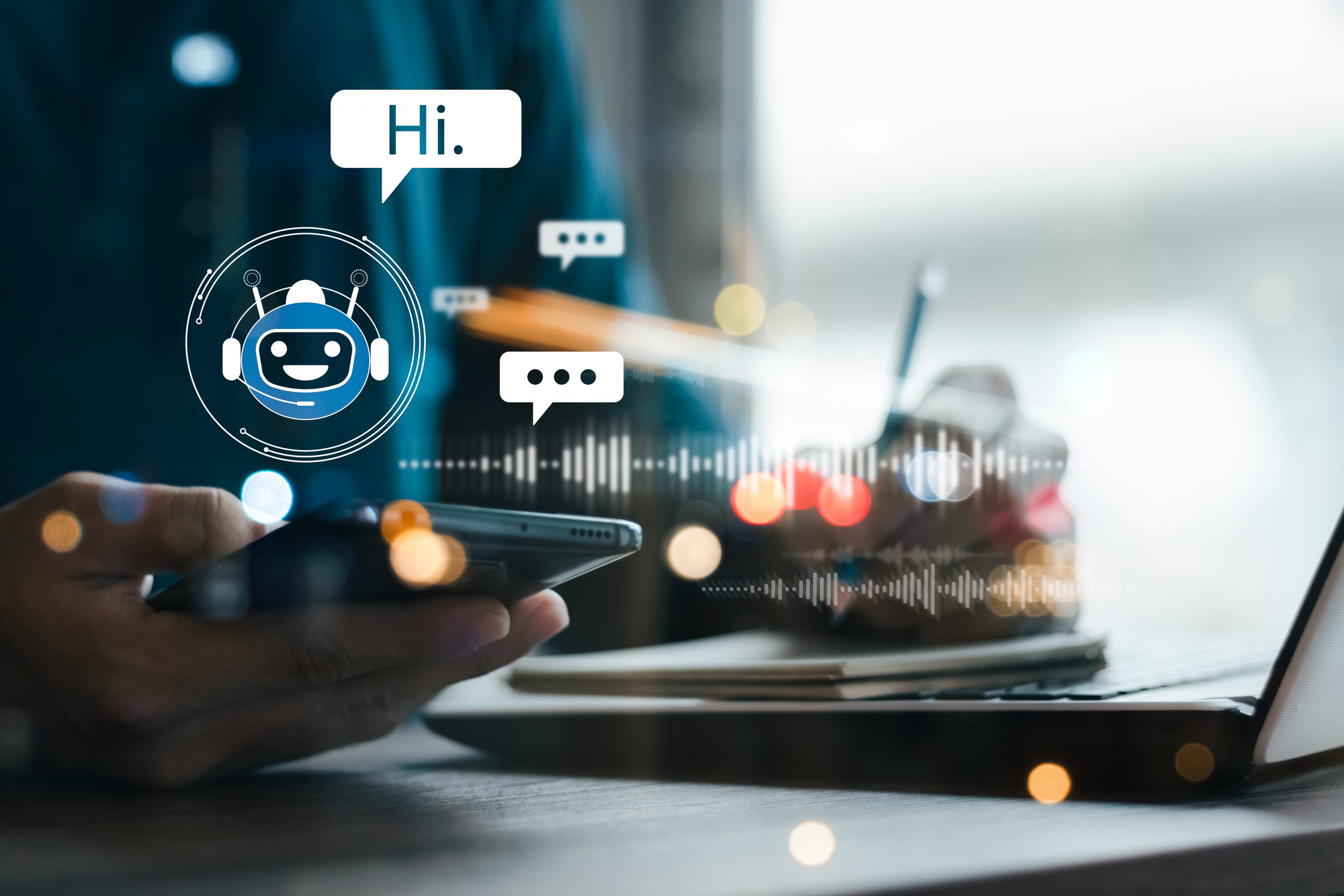Most people interact with chatbots daily without giving them much thought. That instant response when you message a company at 3 AM comes from automated software, not a sleepless employee.
A chatbot is a program built to have conversations with humans. The simplest ones work like flowcharts—they recognize specific words and spit out matching answers. Ask about store hours, get the hours. Ask about returns, get the return policy. Nothing fancy, but it gets the job done.
The technology has improved dramatically over the past few years. What started as clunky automated phone menus has evolved into systems that feel almost human in their responses.
What Is a Chatbot?
A chatbot is a tool that is created to chat with people. Think of it as software that can hold a conversation, whether through typing or voice. The basic ones aren’t that impressive. They work off scripts and keyword matching. The interesting ones use AI. These can actually figure out what you’re asking, even if you word it oddly. They pick up on context from earlier in the conversation. Over time, they get better at their job through machine learning.
Where do you see them? Everywhere, honestly. That chat box on a company’s website offering help. It can help you reschedule a doctor’s appointment through text. The system walks you through returning an online purchase. Banks use them. Hotels have them. Even local businesses are starting to deploy simpler versions. The appeal is obvious from a business standpoint. Chatbots handle repetitive questions without complaint. They work nights, weekends, and holidays. Customers get faster responses than waiting for email. The technology has come a long way from those frustrating automated phone systems everyone hated. Today’s versions can sound surprisingly natural. Some are good enough that you might not immediately realize you’re talking to a machine.
How Have Chatbots Evolved? From Simple Scripts to Smart Assistants
Chatbots started crude and got sophisticated fast. The first versions appeared in the 1960s with ELIZA, a program that mimicked a therapist by reflecting questions back at users. Though it was clever for its time, it was still limited.
Through the 1990s and early 2000s, chatbots were mostly rule-based systems. They operated like phone trees—rigid, frustrating, and easily confused by anything off-script. People dreaded interacting with them.
Everything changed when machine learning and natural language processing matured. Suddenly, chatbots could understand intent instead of just matching keywords. They started to understand context and handle complex conversations.
The smartphone era accelerated development. Voice assistants like Siri introduced millions to conversational AI. Messaging apps gave chatbots new platforms to live on.
Today’s versions are radically different. They can now integrate with business systems, pull real-time data, and personalize responses. Some use retrieval-augmented generation to search knowledge bases before answering. Others employ sentiment analysis to detect frustration and adjust according to it.
The gap between talking to a bot and talking to a human has narrowed considerably. Many can now handle transactions, solve problems, and maintain conversations that are more helpful rather than robotic.
The Value of Chatbots: Why Businesses Keep Adding Them
Chatbots deliver real benefits that show up on balance sheets. Companies get 24/7 customer support without hiring night shifts. That alone saves significant money on staffing costs.
Response times drop dramatically. Customers get instant answers instead of waiting hours for email replies or sitting on hold. That speed matters—people expect quick responses now, and chatbots deliver consistently.
They scale effortlessly. One chatbot handles ten conversations or ten thousand simultaneously. Human teams can’t match that during traffic spikes like product launches or holiday sales.
The data collection aspect often gets overlooked. Chatbots track every interaction, revealing patterns in customer questions and pain points. Companies use these insights to improve products and services.
Employees benefit too. When chatbots handle repetitive questions about passwords, shipping status, and store hours, human staff can focus on complex problems that actually need human judgment. Job satisfaction typically improves when people aren’t answering the same basic questions all day.
Lead generation improves as well. Chatbots engage website visitors immediately, qualify prospects, and route serious buyers to sales teams. They capture potential customers who might otherwise leave without making contact.

What Are the Types of Chatbots? Breaking Down the Categories
There are different types of chatbots that any business uses now. Each one works differently and handles different jobs.
Rule-Based Bots
These follow scripts and decision trees. You click an option, they give you the matching answer. Think of them as fancy automated menus. They’re cheap and predictable but can’t handle anything outside their programming.
Keyword Spotters
They scan your message for specific words. Type “refund” and they pull up refund info. A bit more flexible than rule-based versions but still easily confused by creative phrasing.
AI Conversational Bots
They actually understand what you’re asking. They process intent, not just keywords. You can say “Where’s my order?” or “When does my package get here?” and they know you mean the same thing. Way better for real conversations.
Generative AI Bots
They write responses from scratch instead of using templates. Sometimes brilliant, sometimes weird. You never quite know what you’ll get, which can be good or problematic depending on the situation.
AI Agents
They don’t just chat—they do things. Need to reschedule an appointment? They actually reschedule it. They connect to real business systems and handle tasks without human backup.
Hybrid Setups
Mix different technologies based on what’s needed. Simple questions get quick scripted answers. Complicated stuff gets handed to the AI. Practical approach that many companies use.
Voice Bots
You talk, they listen and respond out loud. Alexa and Siri fall into this category. Same basic technology as text bots with speech recognition layered on top.
Contextual Bots
They remember what you said earlier in the conversation. You don’t have to repeat yourself constantly. Makes the whole experience feel less mechanical.
Companies usually choose based on what they need and what they can afford. A small business answering basic questions? Rule-based works fine. Major retailers handling thousands of support tickets? AI makes more sense.
What Are Other Technologies Related to Chatbots? The Broader Ecosystem
Chatbots don’t exist in isolation. Several related technologies overlap and sometimes get confused with each other.
- Virtual agents handle more complex interactions than basic chatbots. They’re designed for full customer service scenarios, not just quick questions. Think of them as chatbots with expanded capabilities and deeper system integrations. They can manage entire support tickets from start to finish.
- Conversational AI is the umbrella term for the technology powering smart chatbots. It includes natural language processing, machine learning, and dialogue management. When people talk about “conversational AI,” they mean the underlying tech stack rather than a specific product you interact with.
- Voicebots handle spoken conversations instead of text. They add speech recognition and text-to-speech on top of chatbot logic. Phone systems use these for customer service lines. The core conversation handling works similarly to text chatbots, but the input and output methods differ.
- Chatbot software refers to the platforms and tools for building bots. Companies sell software that lets businesses create and deploy their own chatbots without coding from scratch. These platforms provide templates, integrations, and management dashboards.
Chatbots vs AI Chatbots vs Virtual Agents: What’s the Difference?
These terms get thrown around interchangeably, but they represent different levels of capability.
Basic chatbots run on rules and scripts. They’re programmed for specific scenarios with predetermined responses. Ask something outside their script and they’re stuck. They handle simple, repetitive tasks well but can’t adapt to complexity. Think of them as digital forms that chat back at you.
AI chatbots understand language and intent. They use natural language processing to figure out what you mean, even if you phrase it oddly. They learn from interactions and handle unexpected questions reasonably well. The conversation feels more natural because they’re not just matching keywords to canned responses.
Virtual agents are AI chatbots with broader authority and deeper integrations. They don’t just answer questions—they take action across multiple systems. Need to process a return, update your account, and schedule a follow-up? A virtual agent handles all three without transferring you. They’re built for end-to-end problem resolution.
The progression makes sense: basic chatbots for FAQs, AI chatbots for support conversations, virtual agents for complex service scenarios. Cost and complexity increase at each level. A small business might only need basic chatbots. A bank probably wants virtual agents who can actually resolve account issues, not just discuss them.
Benefits of Chatbots: Why Businesses Keep Adding Them
Chatbots deliver real advantages. They show up in customer satisfaction scores and financial reports both. The benefits touch nearly every part of how businesses operate.
Always On, Never Off
People need help at 2 AM just as much as 2 PM. Chatbots don’t clock out. Round-the-clock support becomes possible without paying for night shifts or weekend coverage. This matters especially for businesses with global customers spread across time zones.
Answers That Don’t Make People Wait
Waiting on hold is miserable. Waiting days for an email reply? Even worse. Chatbots respond immediately. Someone asks about shipping and gets an answer in two seconds. Response times collapse from hours to moments. That speed directly affects whether customers stick around or go elsewhere.
They Handle Crowds Without Stress
A customer service rep might juggle three conversations before things get messy. Chatbots? They handle hundreds at once without breaking a sweat. Black Friday traffic spike, product launch chaos, unexpected viral moment—the bot just keeps going. No emergency hiring. No overwhelmed staff. No customers waiting in digital lines.
The Money Part Is Hard to Ignore
Each question a chatbot answers is one a human doesn’t have to. The labor savings add up fast. Most companies see return on investment within months once they’re past setup costs. Volume makes the economics even better. Handling 10,000 queries per month costs roughly the same as handling 1,000.
Catching Customers Before They Leave
Website visitors bounce constantly because nobody’s there to help right away. Chatbots engage instantly. They figure out what people need and either solve it or connect them to the right human. Email addresses and phone numbers get captured from folks who would otherwise just disappear. Conversion rates climb when every visitor gets immediate attention.
Same Answer Every Single Time
Human agents have off days. They forget things. Policy explanations vary depending on mood and memory. Chatbots deliver identical, accurate information in every conversation. The knowledge is already there and never degrades. New hires don’t need six months to memorize everything.
Personalization Without Manual Work
Good chatbots check your history before responding. What you bought last month. What issue did you call about last week? They know. That personalized touch happens automatically for everyone simultaneously. Customers feel recognized without companies needing armies of people manually reviewing accounts.
Learning What Customers Actually Need
Every conversation feeds data back. What confuses people, what they ask about most, where products fall short. Patterns emerge that individual support tickets might miss. Businesses use these insights to fix actual problems instead of guessing what needs improvement.
Letting Humans Do Human Work
Nobody was dreaming about becoming a customer service agent. When chatbots handle the repetitive stuff, people tackle problems requiring actual judgment and empathy. Job satisfaction goes up. Skilled employees spend their energy on work that matters instead of explaining store hours for the hundredth time.
Speaking Every Language at Once
Quality chatbots switch between languages seamlessly. Spanish, Mandarin, Arabic—no problem. A business can support customers in multiple languages without hiring specialized staff for each.
The technology has limitations and frustrations, sure. Nobody’s pretending chatbots are perfect. But the benefits explain why adoption keeps spreading across industries of all sizes. Companies implementing them well see measurable improvements in how customers feel about them while spending less to deliver that experience. That combination is tough to ignore.

Risks and Limitations of Chatbots: What Can Go Wrong
Chatbots fix some problems while creating others. Here’s what actually happens when things go sideways.
They’ll Lie Straight to Your Customer’s Face
AI chatbots invent stuff. A customer asks about returns and gets told 60 days when your policy says 30. Someone checks if a product fits their car model and the bot says yes when it definitely won’t. The really annoying part? It sounds totally wrong to be completely wrong. There’s no way to catch every made-up answer before it reaches someone.
Security Gets Ignored Until Something Breaks
Think about what these things touch. Bank details. Medical records. Home addresses. Credit card numbers. Every single conversation is a potential disaster waiting to happen. Hackers already figured out that chatbots are often the weakest link. Big companies have gotten burned. And European privacy laws don’t mess around—screw up once with customer data and you’re looking at fines that hurt.
Basic Understanding Just Isn’t There
Context goes right over their heads. Someone says your product is “sick” meaning awesome and the bot asks what’s wrong with it. Use any sarcasm and it takes you dead seriously. Regional expressions might as well be ancient Greek. These screw-ups don’t just waste time—they make your whole operation look incompetent.
They’re Blind to What Matters
People don’t talk in neat little boxes. Someone mentions their actual problem and it doesn’t match your button options. The bot just sits there useless. Can’t adapt, can’t improvise, can’t recognize that this person needs actual help. You’re losing sales opportunities, missing warning signs about product issues, and letting customers slip away frustrated.
The Work Literally Never Stops
Your product line changes. Pricing updates. Customers dream up new ways to ask questions. This thing needs constant feeding and care. Someone’s gotta review what went wrong yesterday, figure out patterns, fix broken responses. The language model needs updates. Your other software changes and breaks the connections. Launching is just the beginning of the work, not the end.
Other Languages Are a Nightmare
Spanish support sounds reasonable on paper. Then you’re actually doing it. Everything that flows naturally in English sounds robotic and weird in Spanish. Cultural references mean nothing. Jokes don’t translate. Idioms come out as word salad. Each language is basically its own separate project. Small companies especially have no idea what they’re getting into.
Zero Memory of Who You Are
People expect the bot to know their history now. What they ordered last time, what broke, what they complained about. When it doesn’t, they get pissed having to explain everything again. But connecting the bot to all that customer data? That’s when those security nightmares from earlier become your problem.
The Human Takeover Is Always Awkward
Eventually a real person needs to step in. That transition is consistently terrible. Everything vanishes. The customer starts over from the beginning with someone who has no clue what just happened. It feels broken and sloppy. People end up thinking nobody at your company talks to each other.
Trapped in a Loop
Basic bots show you three choices. None of them match what you need. You pick the least-wrong option. Now you’re stuck in responses about the wrong thing entirely. No way back, no escape hatch, just irrelevant answers. The cheapness that made these bots appealing makes them maddening to actually use.
Almost Human Is Worse Than Obviously Robot
Good chatbots have their own weird problem. They’re close enough to humans that the gaps become creepy. Phrasing feels slightly wrong. The tone doesn’t quite match the situation. That uncanny valley thing happens where it’s almost right but clearly off. Sometimes people prefer obviously robotic responses over this almost-but-not-quite-human vibe.
No Emotional Intelligence Whatsoever
Someone’s clearly upset and the bot stays cheerful. A situation obviously needs a manager and it keeps trying to help. They can’t read anger, detect urgency, or know when they’re making things worse. Just keep grinding along until customers lose it completely.
One Size Fits Nobody
Chatbots work great for the middle 70% of questions. The other 30% of edge cases and weird situations? Total failure. But those edge cases are often your most valuable customers or your biggest potential problems. The bot treats everyone exactly the same regardless of whether it should.
What Are Use Cases for Chatbots? Real-World Applications That Actually Work
Chatbots have moved past the hype stage. Companies now use them for specific tasks that solve actual problems.
Autonomous Customer Service
Most businesses start here. Chatbots field the constant stream of basic questions about order status, shipping times, and return policies. The stuff that doesn’t need human thinking but eats up hours of support time. One bot handles hundreds of these conversations simultaneously while real people tackle complicated problems. This matters especially when customers are scattered across time zones expecting answers at odd hours.
Appointment Scheduling
Medical offices, hair salons, and consulting firms rely on these heavily now. The bot checks availability, books slots, sends confirmations, and handles rescheduling. Phone tags and email chains become unnecessary. Dentist offices particularly love the automated reminders that cut down on no-shows.
Sales Promotion
Retail bots guide people toward products without being pushy. Someone lands on your site looking for winter jackets and the bot asks a few questions before suggesting actual options that fit their needs. The smart ones check previous purchases and recommend things that make sense together. Conversion rates climb because people find what they need faster instead of getting lost browsing endless catalogs.
Password Resets
IT departments drown in these requests. Bots can solve these problems easily without human involvement. Basic tech support works the same way—walking through router restarts, checking system status, covering standard troubleshooting steps. IT staff can focus on problems requiring actual expertise instead of resetting passwords all day.
Data Collection
Traditional surveys sit there ignored. Chatbots turn feedback into conversation instead of homework. After a purchase or support interaction, the bot asks a few questions naturally. Response rates blow away those sad email surveys. Companies get real insight into what’s working and what’s broken.
FAQ Responses
Static FAQ pages collect dust while people contact support anyway. Chatbots answer the same information conversationally. They understand different ways of asking identical questions. The systems learn which questions pop up constantly and start surfacing answers proactively. Actually gets used unlike those buried help pages.
Call Center Applications
The bot attempts resolution before anyone reaches a human agent. It works surprisingly often. When it doesn’t, the bot has already gathered context and routed the person to the right department. Call volumes drop noticeably. Wait times shrink. Human agents handle callers who’ve already moved past basic troubleshooting.
Automated Employee Service
New hires arrive with endless questions about benefits, policies, and internal processes. HR bots answer instantly instead of making people dig through hundred-page handbooks or wait for email replies. The systems also process routine requests like time-off submissions and payroll questions. Your staff can focus on situations which require human judgment.
Enterprise Productivity
Inside enterprise companies, bots help people locate information fast. Someone needs last quarter’s sales figures and the bot retrieves them. Another person wants the updated vacation policy and gets it immediately. Expense report submission happens through the bot. Time wasted hunting through systems or bugging colleagues for basic information drops dramatically.
Personal Assistants
Voice assistants on phones handle this space. They set reminders, check weather, control smart home devices, and play music. Same chatbot technology, different interface. The convenience factor becomes obvious when your hands are busy but you still need things done.
Personalized Recommendations
Streaming services suggest shows based on viewing history. Shopping sites recommend products that complement previous purchases. Content platforms surface articles matching your interests. The bot learns behavioral patterns and makes educated guesses that often land correctly. Happens automatically at scale for every user.
Order and Inventory Tracking
Online shoppers check order status themselves without contacting anyone. The bot pulls real-time shipping data and answers instantly. Stock availability gets confirmed the same way. Support ticket volume drops significantly for retailers. Customers get information faster than waiting for human responses.
Omnichannel Customer Service
Conversations start on the website, continue via text message, and finish in the mobile app. Context persists across all channels. Nobody repeats themselves. Requires proper integration but delivers seamless experiences when implemented correctly. People switch between channels based on convenience without losing continuity.
Chatbot Applications by Industry: Where They’re Actually Making a Difference
Industries have figured out their own uses for chatbots which solve problems in one sector that don’t necessarily translate elsewhere.
Healthcare
Medical offices have grabbed onto chatbots mostly for appointments and basic screening. Your dentist’s bot books your teeth cleaning. It can send reminders about refills. Before you even contact the nurse, the bot asks what’s wrong and how long it’s been happening. Privacy laws make healthcare chatbots way more complicated because there are regulations around medical data. But doctor’s offices still use them because the time savings are real. You get answers about basic stuff right away instead of calling during lunch, getting put on hold, and listening to that awful elevator music while someone checks the schedule.
Retail and E-commerce
Shopping bots help you find stuff, follow your orders, and deal with returns. Looking for winter boots and the bot starts asking questions—what size, how much you want to spend, what style you’re into. Narrows things down fast. Once you buy, it tracks your package and tells you exactly where it is. Need to return something? The bot handles it without passing you off to anyone. Retailers see their sales numbers actually go up when people find what they’re after quickly instead of clicking around getting annoyed and leaving.
Banking and Finance
Checking your balance, moving money between accounts, reporting your card got stolen—banks handle all this through bots now. Things that used to mean calling during their hours. Security is obviously intense since we’re talking about your money and personal financial info. But these bots deal with so much routine stuff that the actual human advisors can focus on helping people plan retirement or figure out investments instead of repeating account balances over and over all day.
Hospitality and Travel
Hotels use bots for bookings, changes, and guest questions. Someone wants to know if the pool’s open or whether breakfast comes with the room—instant answer. Airlines have them tracking flights, announcing gate changes, and rebooking you when everything falls apart. The 24/7 thing really matters here since travelers are scattered across every time zone imaginable. Finding out your flight got canceled at 3 AM and having to wait until the front desk opens at 9? Nobody’s dealing with that anymore.
Real Estate
Property managers and agents use bots to screen potential tenants and set up showings. Someone asks about an apartment at 11 PM. Bots grab their info, check if their budget works, and schedule a time to see the place. Response time goes from tomorrow afternoon or next week down to right now. That speed matters because people looking at apartments are usually checking out five other places too.
Education
Universities have bots which handle admissions questions, course info, and general student stuff. Prospective students ask about programs, when applications are due, what the dorms look like. Current students check when their paper’s due, where to find something in the library, or which office handles their particular problem. Takes care of all the repetitive questions that would otherwise bury the admin staff under an avalanche of emails.
Insurance
Policy details, claim status, getting quotes—insurance bots do all of it. Filing a claim walks you through everything step by step. Want to know what’s covered? Instant answer instead of calling and waiting. Comparing quotes for different coverage levels happens without some agent calling you back three days later during their office hours.
The pattern holds everywhere. Chatbots handle repetitive, high-volume stuff that follows clear rules. Each industry bends the technology around whatever’s eating up their time. Healthcare needs scheduling. Retail needs help finding products. Banking needs basic account stuff. What works is figuring out which interactions actually get better with automation and which need a real person making judgment calls. Get that wrong and you’re spending money to make customers mad.
What Are the Examples and Use Cases of Chatbots? Real Applications in Action
Chatbots pop up everywhere now. Some actually work well enough to talk about.
Customer Support at Scale
Ecommerce stores use chatbots to answer order questions all day and night. Someone in Australia asks about shipping at 3 AM New York time and gets an immediate response. Bot checks order status, pulls up tracking info, handles common problems. Volume that would need a huge support team gets managed through automation instead.
Lead Qualification That Never Sleeps
Real estate companies stick chatbots on their listing pages. Potential buyer shows up at midnight browsing a property, starts asking about square footage and local schools. Bot figures out their budget range, grabs contact details, books a showing time. The agent wakes up to actual qualified leads instead of random people who might just be killing time online.
Healthcare Appointment Management
Dental offices use bots connected directly to their scheduling software. You need a cleaning, the bot shows what’s available, locks it in, sends you confirmation plus reminders as it gets closer. No calling during lunch and getting stuck on hold. Fewer no-shows because people get nudged multiple times.
Banking Without Branch Hours
Big banks run bots for routine account stuff. Checking balance, moving money around, paying bills, flagging weird charges. Things that used to mean driving to a branch or calling during their limited hours now happen whenever you think of it. Fraud alerts come through right away with simple buttons to confirm whether that charge was really you.
Restaurant Reservations and Orders
Restaurants let you order pizza completely through their bot on different apps. It remembers what you ordered last time, suggests tweaks, tells you when the driver’s getting close. A bot books tables, answers menu questions, handles waitlists when restaurants are slammed.
Travel Planning and Support
Airlines use bots for booking flights, checking in, getting status updates, rebooking when things fall apart. Hotels deploy them for reservations, room service, and answering questions about amenities. Travelers get instant answers instead of waiting in endless phone queues or standing behind a crowd at the front desk.
E-learning and Training
Online course platforms use chatbots as study buddies. Students ask about material they’re confused on, find relevant videos or readings, check when assignments are due. Companies use them for employee training too—bots quiz people, track who’s actually finishing modules, re-explain tricky concepts when someone’s struggling.
HR and Internal Support
Big organizations deploy bots for onboarding and routine HR stuff. The new employee wants to know how benefits work, what the vacation policy is, how to submit expenses. Bot walks them through everything instead of HR answering the same five questions fifty times a day via email.
The ones that work share some traits. They tackle specific repetitive tasks with straightforward answers. They connect to real systems so they can actually do things, not just talk about doing them. They know when they’re in over their heads and need to grab a human. The disasters happen when companies try automating stuff that needs judgment calls, reading emotional cues, or genuine empathy—things bots still can’t pull off convincingly.

How to Create a Chatbot: Steps That Actually Work
Building a chatbot isn’t rocket science, but it’s messier than the sales pitches make it sound. Here’s what really happens.
Define Your Chatbot’s Purpose
Figure out what specific problem you’re actually solving. Don’t build one just because your competitor has one or your boss read an article. Pick tasks—scheduling appointments, checking order status, answering the same ten questions your support team hears daily. Narrow focus wins. Trying to make it do everything guarantees it’ll do nothing well.
Develop Knowledge Articles
Your bot needs real information to work with. Dig through old support tickets and emails. What do people actually ask about? Write clear answers for each common question. This boring groundwork matters more than anything else. Skip it and your bot will confidently spew nonsense at customers.
Choose Your Channels
Where will this thing live? Website popup? Text messages? Facebook? Don’t spread yourself thin trying to be everywhere immediately. Pick one channel where your customers already are. Pizza shop? Probably SMS. B2B software? Maybe your website. Going after every platform at once is how projects die.
Choose a Platform
Find software that matches your skills and wallet. Stuff like Zendesk or ManyChat offers templates and visual builders if you’re not technical. Developers might want DialogFlow or custom builds. Think about what it needs to connect to—your customer database, scheduling system, whatever you’re already running. Integration headaches kill more chatbot projects than anything else.
Design Your Chatbot’s Workflow
Sketch out conversations on paper before touching any software. The customer asks about returns—then what? They get frustrated and want a human—how does that transition work? Map the paths conversations can take. Plan different chaos—typos, weird phrases, people who can be mad or something like that. This planning separates bots that feel conversational from ones that feel like fighting a phone tree.
Add NLP
Natural language processing helps your bot understand intent instead of just matching exact phrases. Someone types “where’s my stuff” and it knows they mean order tracking, not a philosophy question. Most platforms include basic NLP now. Fancier understanding requires more setup or bringing in additional tools. Don’t obsess over this initially—get the basics working first.
Test Your Chatbot
Beat it up before customers see it. Get anyone you can find to try breaking it. Throw typos at it. Use slang. Act pissed off. Ask completely unrelated questions. Make sure handing off to real people actually works smoothly. Verify your integrations don’t just work in theory. Finding failures now saves you from public embarrassment later.
Deploy and Monitor
Soft launch to a small group if possible. Watch every conversation at first like you’re studying for an exam. See where it works and where it face-plants. Grab feedback from anyone willing to give it. Expect to spend weeks or months refining after launch—adding responses, fixing misunderstandings, adjusting flows. Most teams underestimate this part badly. The real work starts after you flip it on.
Building something halfway decent takes weeks minimum. Complex stuff takes months. Rushing through these steps produces terrible experiences that make customers hate you. There’s no magic shortcut. Do it right or don’t bother.
The Future of Chatbots: Where This Technology Is Heading
Chatbots are getting smarter fast. The gap between talking to a bot and talking to a person keeps shrinking.
Voice integration is expanding beyond simple commands. Future bots will handle complex spoken conversations naturally across more languages and dialects. They’ll pick up on tone and emotion better, adjusting responses when someone sounds frustrated or confused.
Personalization will go deeper. Bots will remember preferences across months of interactions, anticipate needs based on patterns, and proactively offer help before you ask. The creepy factor exists, but so does genuine convenience.
Integration with other AI systems is coming. Your chatbot won’t just answer questions—it’ll coordinate with AI handling scheduling, inventory, analytics, and operations. One conversation triggers actions across multiple systems automatically.
Predictive capabilities will improve. Bots will spot problems before they escalate, suggest solutions preemptively, and learn from outcomes to get better over time. Less reactive support, more proactive assistance.
The technology won’t replace humans entirely. Complex situations requiring judgment, empathy, and creativity still need people. But the line defining what bots can handle keeps moving. What seems impossible today becomes standard in a few years.
Frequently Asked Questions About Chatbots
Chatbots usually do one thing—answer common questions, track orders, book appointments. Virtual assistants handle way more. They juggle multiple tasks, connect to different systems, and solve problems from start to finish. Chatbots are specialists. Virtual assistants are more like actual assistants.
Yeah, many do now. Quality’s all over the place though. Some just run everything through translation and it sounds robotic and weird. Better ones are actually trained in each language separately so they handle slang and cultural stuff properly instead of translating word-for-word like a confused tourist.
All over the map. Simple ones using templates might run a few hundred bucks a month for the software. Custom AI-powered bots with tons of integrations can hit tens of thousands to build plus whatever it costs to keep them running. Most fall somewhere in between.
Not completely. They handle the repetitive stuff so actual people can deal with complicated problems that need judgment calls and empathy. Good setups use bots for first contact with easy handoffs to humans when things get messy. Companies that tried firing everyone and going full bot usually ended up backtracking.
Basic ones can go live in a few weeks. Complicated ones take months. That’s just to launch though. You’ll spend way more time after that tweaking things based on how people actually use it. Most teams don’t realize how much work comes after the “done” part.
Depends how it’s built. Good ones admit they’re lost and either offer other options or grab a human. Bad ones just loop through the same useless responses or keep telling you to rephrase until you give up and leave angry.
They can be. Doesn’t happen automatically though. You need encryption, privacy compliance, and careful data handling. Bots dealing with banking or medical stuff especially need serious security. Plenty of companies have gotten burned by treating this casually.
AI ones can. They study what works and what doesn’t to get better. Basic bots just follow their script—they don’t learn anything. Someone has to manually update them after reviewing what went wrong.
There isn’t one universal answer. Depends on your tech skills, budget, what systems you need it talking to, what you’re trying to accomplish. Zendesk, Intercom, ManyChat, DialogFlow all get used a lot. Pick based on your actual needs instead of whatever’s trendy.
Yeah, most work fine on phones. They show up in apps, texts, mobile browsers, messaging platforms. You should definitely test on mobile though since tons of people only use their phones. Desktop-only testing misses half your problems.
Conclusion: Moving Forward with Chatbots
Chatbots have moved from experimental tech to practical business tools. They handle repetitive tasks, scale customer support, and operate around the clock without the overhead of large teams. The technology keeps improving—better language understanding, smoother integrations, more natural conversations.
Success comes from realistic expectations. Chatbots excel at high-volume, predictable interactions. They struggle with nuance, complex problems, and situations requiring human judgment. Companies that understand these boundaries see real results. Those that oversell capabilities end up with frustrated customers and wasted investments.
Implementation takes planning, testing, and ongoing refinement. It’s not plug-and-play despite what sales pitches suggest. But done right, chatbots deliver measurable improvements in response times, cost efficiency, and customer satisfaction.
Ready to explore how chatbots could work for your business? We help companies design, build, and deploy chatbot solutions that actually solve problems instead of creating new ones.




